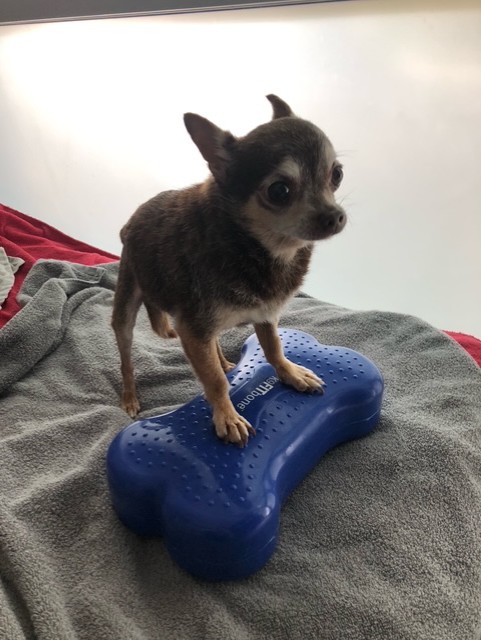This weeks Wisdom Wednesday is all about doggie PT! Our very own Hershey had surgery to correct both of his knees a couple of years ago, and he still needs physical therapy to strengthen his leg muscles and continue working on his knee. He gets daily massages and stretches of his sartorius muscle in addition to doing targeted leg-strengthening exercises. To provide extra stability during his workouts, he even wears the world’s smallest braces! His routine is further supported by using a balancing disc and even a yoga block! And of course, the most important part of his physical therapy sessions? The treats! Hershey is extremely treat-motivated (and only the good treats will do) and works exceptionally hard during each session.
Maintaining your dog’s joint health is crucial, especially when dealing with conditions like luxating patella (dislocated kneecap) and hock joint instability. These issues can hinder mobility and cause discomfort, but with targeted physical therapy, appropriate exercises, and supportive products, you can significantly improve your dog’s muscle strength and joint stability.
*Before starting any new exercise regimen or introducing supportive products, consult with your veterinarian or a certified canine rehabilitation therapist. They can tailor a program specific to your dog’s needs, ensuring safety and effectiveness.*
Incorporating specific exercises into your dog’s routine can strengthen muscles and enhance joint stability:
1. Hill Walks: Walking your dog slowly up and down gentle slopes strengthens the hind limb muscles and improves joint flexibility. Ensure the incline is not too steep to prevent strain.
2. Figure Eights: Guiding your dog through figure-eight patterns encourages balance and coordination, engaging various muscle groups essential for joint support.
3. Sit-to-Stand Transitions: Encourage your dog to sit and then stand repeatedly. This simple exercise builds quadriceps strength, crucial for stabilizing the patella.
4. Passive Range of Motion (PROM): Gently flex and extend your dog’s hock joint to maintain mobility and reduce stiffness. Perform these movements slowly and within your dog’s comfort range.
Utilizing supportive devices can aid in managing these conditions:
• Knee Braces: Designed to stabilize the knee joint, knee braces can prevent the patella from dislocating during movement, thereby reducing pain and preventing further damage.
• Hock Wraps: These provide compression and support to the hock joint, aiding in injury recovery and offering stability during physical activity.
• Rear Leg Slings: Assistive slings help support the hind end, reducing strain on misaligned joints and aiding in mobility.
Please enjoy this video of our sweet Hershey being a trooper during his at home physical therapy!

